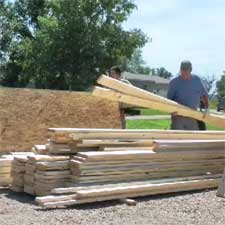Every few years it seems there arises a need for young (remember I am only 62 years young) men to head into forests and become loggers. I have been there personally – there is just something manly about hacking down some snags with a chain saw! Myself, there is a sudden rush when a tree starts to fall….makes my arm hairs stand on end!
These newly felled trees often become raw material for backyard sawmills. I have seen a few requests for post frame buildings recently where prospective clients want to use their own home milled lumber.
BAD IDEA.
I equate this concept of “free” home milled lumber to my sons who hunt and fish to provide “free” meat for their families.
Now if these persons would have been doing any sort of internet searching on this subject, they might have stumbled upon a previous article of mine: https://www.hansenpolebuildings.com/2011/09/ungraded-lumber-using-home-milled-timber/
Adding to this article (better actually go read it, eh?), are these excerpts from 2018’s IBC (International Building Code):
2303.1.1 Sawn lumber.
Sawn lumber used for load-supporting purposes, including end-jointed or edge-glued lumber, machine stress-rated or machine-evaluated lumber, shall be identified by the grade mark of a lumber grading or inspection agency that has been approved by an accreditation body that complies with DOC PS 20 or equivalent. Grading practices and identification shall comply with rules published by an agency approved in accordance with the procedure of DOC PS 20 or equivalent procedures.
2303.1.1.1 Certificate of Inspection.
In lieu of a grade mark on the material, a certificate of inspection as to species and grade issued by a lumber grading or inspection agency meeting the requirements of this section is permitted to be accepted for precut, remanufactured or rough-sawn lumber and for sizes larger than 3 inches nominal thickness.
Keep in mind, Code requirements are only bare minimum standards for safe construction. In my humble opinion, pushing risks of a failure from an ungraded piece (or pieces) of lumber used structurally is a face slap to already minimal practices.
Be safe, be sane and be practical. Don’t use home milled lumber for any part of a post frame building.







